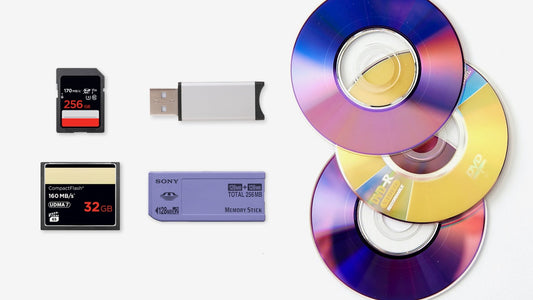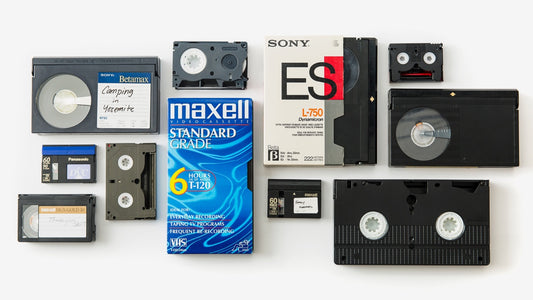Every family has its own unique collection of stories, mysteries, and legends waiting to be uncovered. Becoming your family’s historian is like embarking on a personal detective story, where every clue brings you closer to understanding your own past. A digital family tree is your case file—the place where you piece together evidence, connect the dots, and reveal the bigger picture. This project is a powerful way to connect with your ancestors and preserve their experiences. In this article, we’ll give you the practical advice and tools you need to create a digital family tree and begin the exciting work of discovering your roots.
Key Takeaways
- A digital tree is an interactive family story: Go beyond names and dates by adding digitized photos and home movies. This transforms your research into a living archive where you can see the faces and relive the moments behind the names.
- Find the right tool for your goals: Choose software based on whether you want a private project or a collaborative one. Prioritize platforms that are easy to use and allow you to export your data, ensuring your hard work is always accessible.
- Preserve your work for the future: Protect your family’s information by managing your privacy settings, especially for living relatives. Create regular backups of your family tree and all your digital media to ensure your legacy is safe for generations to come.
What Is a Digital Family Tree?
Think of a digital family tree as your family’s story, brought to life on your computer or online. It’s more than just a list of names and dates; it’s a visual map that shows how everyone is connected, from your great-great-grandparents down to the newest baby in the family. Instead of a fragile paper chart tucked away in a box, a digital tree is a living document you can easily update, share, and expand. It’s an online representation of your lineage that you can enrich with photos, stories, and even old home videos.
Creating one is a fantastic way to organize all the bits and pieces of your family history you’ve collected over the years. You can see relationships at a glance and trace your roots back through generations. What makes it truly special is the ability to add personal touches. Imagine clicking on your grandmother’s name and seeing her wedding photos or watching a video from a family reunion decades ago. By pairing your tree with digitized memories from services like photo transfer or video transfer, you’re not just building a chart—you’re creating an interactive family archive that everyone can explore and enjoy.
Why Create a Digital Family Tree?
Building a digital family tree is a powerful way to preserve your family’s legacy. It ensures that the stories, names, and faces of your ancestors aren’t lost to time. It’s a project that allows you to share their ancestry with younger generations, giving them a tangible connection to where they come from. Plus, it’s a wonderful collaborative activity. You can invite relatives to contribute their own memories and knowledge, turning it into a shared family heirloom. As you piece together your history, you’ll uncover fascinating details and strengthen your bond with family, both past and present.
What Are the Different Types?
Digital family trees come in a few different flavors, so you can choose what works best for you. The main options are collaborative platforms and standalone software. Collaborative sites, like FamilySearch, allow multiple people to contribute to a massive, shared family tree. This is great for connecting with distant relatives who might have pieces of the puzzle you’re missing. On the other hand, standalone software gives you complete control over your own private tree. Some tools focus on creating beautiful, visual charts perfect for printing, while others are built for serious data management and record-keeping.
What to Look For in Family Tree Software
Choosing the right family tree software is a bit like picking a new notebook—you want one that feels good to use and has all the features you need to get your thoughts down. With so many options out there, it helps to know what to look for. The best platforms make it simple to build, manage, and share your family’s story. Think about how you plan to work on your tree and who you want to involve. Focusing on a few key features will help you find the perfect tool for bringing your family history to life.
An Easy-to-Use Interface
Your journey into family history should be exciting, not a technical headache. That’s why a simple, intuitive interface is non-negotiable. You want software that feels natural to use from the moment you sign up. Look for platforms with ready-to-use templates that let you start adding family members in minutes, not hours. Features like drag-and-drop functionality and clear navigation mean you can spend more time discovering your roots and less time figuring out how the software works. A clean design helps you visualize your family connections and see your history unfold without unnecessary clutter.
Tools for Family Collaboration
Family history is rarely a solo project. Your relatives hold puzzle pieces you might not have, from old photos to stories about great-grandma. The best family tree software makes it easy to work together. Look for collaboration tools that let you invite family members to view or edit the tree. Some platforms allow you to share your work with a simple link, so even less tech-savvy relatives can contribute their knowledge. Working together not only makes the process more fun but also helps create a richer, more accurate family story for everyone to enjoy.
Simple Data Management
As your family tree grows, you’ll be juggling a lot of information: names, dates, locations, and personal stories. Good software needs to handle all this data without becoming slow or disorganized. One of the most important features to look for is the ability to import and export your data using a GEDCOM file. This is a universal format for genealogical data, which means you can easily move your family tree from one program to another if you ever decide to switch. This flexibility ensures your hard work is never locked into a single platform.
Connections to Historical Records
This is where the real detective work begins. Some family tree platforms have built-in connections to massive databases of historical records. This feature is a game-changer, allowing you to search for ancestors in census data, military records, and immigration lists directly from your family tree. It can help you verify information and uncover new branches of your family you never knew existed. Many local libraries also offer free access to paid services like Ancestry.com, so be sure to check what resources are available in your community to support your research.
Easy Sharing and Exporting
Once you’ve created a beautiful family tree, you’ll want to share it. Look for software that gives you flexible options for exporting your work. You should be able to save your tree as a high-quality PDF for printing or save it directly to a cloud service like Google Drive or Dropbox. This makes it easy to send to relatives or access from any device. Being able to easily share your tree ensures your family’s legacy is preserved and can be passed down, just like the memories you capture through photo transfer and home movie digitization.
How to Choose the Right Family Tree Platform
With so many options out there, picking the right platform can feel like a big decision. The best choice really comes down to your goals, budget, and how you want to work. Are you a solo researcher who loves digging into details, or do you want to create a beautiful, collaborative tree with your cousins? Some tools are simple and free, while others offer powerful features for a subscription. Let’s break down the main types so you can find the perfect fit for your family’s story.
Top Paid Options
If you’re serious about genealogy and want access to powerful research tools, a paid platform is often worth the investment. These services go beyond basic tree-building, offering features that help you manage complex family lines and uncover new information. For example, software like Family Tree Maker allows you to use color-coding to distinguish different family branches and maintain alternate facts when you find conflicting records. Paid subscriptions also typically grant you access to vast databases of historical documents, like census data and marriage certificates, which are essential for tracing your roots back through generations.
Great Free Tools
You don’t need a big budget to start building your family tree. There are some fantastic free tools available that are perfect for beginners or for those who simply want to map out their known family members. Websites like Family Echo offer a straightforward way to create, share, and print your tree online while keeping your information private. Others, like SmartDraw, provide ready-to-use templates to get you started quickly. Even popular sites like Ancestry.com let you build a family tree for free, with no limit on how many people you can add, which is a great way to get organized before deciding if you need a paid subscription.
Cloud vs. Desktop: Which Is Better?
One key decision is whether to use a cloud-based platform or desktop software. Desktop programs are installed directly on your computer, giving you complete control and privacy over your data—no one else can see or change it unless you share the file. This is a great option if you prefer to work offline. On the other hand, cloud-based tools are accessible from any device with an internet connection. They make it incredibly easy to share your tree and invite relatives to contribute, turning your project into a collaborative family effort. The best choice depends on whether you prioritize privacy and control or accessibility and teamwork.
What to Consider for Your Budget
When thinking about cost, it’s helpful to know that many platforms operate on a "freemium" model. This means you can build your family tree for free, but accessing the full library of historical records requires a paid subscription. Before you commit, consider what you want to accomplish. If your goal is to create a beautiful chart of your living relatives to share at a family reunion, a free tool will likely have everything you need. If you’re hoping to solve family mysteries and trace your lineage back centuries, investing in a subscription that provides access to historical records will be essential for your research.
Build Your Digital Family Tree, Step-by-Step
Creating a digital family tree is a rewarding project that connects you to your roots and preserves your family’s story for future generations. It might seem like a huge undertaking, but you can build a beautiful, detailed tree by breaking it down into a few simple steps. Think of it as a puzzle where you get to discover and piece together the amazing story of you. Let's walk through how to get started, from gathering the first names to adding the finishing touches.
Gather Your Family Information
The best place to start your family tree is with what you already know. Begin with yourself, then add your immediate family: parents, siblings, partner, and children. From there, you can branch out to grandparents, aunts, uncles, and cousins. Don't worry about having every detail right away. Just get the basic structure down.
Once you've mapped out your immediate family, it's time to do a little detective work. Chat with older relatives who can fill in gaps and share stories you’ve never heard. Look through old family Bibles, letters, and certificates for names, dates, and locations. Every small piece of information is a clue that helps you build a more complete picture of your heritage.
Organize Your Research
As you collect names, dates, and stories, you'll quickly find you have a lot of information to manage. It's a good idea to create a system to keep everything organized from the start. A simple spreadsheet can work wonders. You can make a family tree in Google Sheets, creating columns for names, birth dates, marriage dates, and other key details. This keeps your research tidy and easy to reference as your tree grows.
Many family tree software programs also have built-in tools for organizing your data. Whatever method you choose, the key is consistency. A well-organized system will save you headaches later on and make it much easier to spot connections and identify areas where you need more information.
Add Photos and Documents
This is where your family tree truly comes to life. Adding photos and documents transforms a list of names and dates into a rich, visual story. Dig out those old photo albums, shoeboxes of loose pictures, and reels of home movies. Seeing the faces of your ancestors makes the connection to your past feel so much more real.
If your memories are stored on old media, you’ll need to digitize them first. Services like photo transfer can convert your prints, slides, and negatives into high-quality digital files. You can even get entire albums scanned without having to remove a single picture. Adding these images to your digital tree gives it personality and helps you share your family’s legacy in a beautiful, engaging way.
Create Clear Family Connections
With your information gathered and your photos digitized, the final step is to connect the dots. Your family tree should clearly show how everyone is related. Most family tree builders make this easy, allowing you to draw lines and establish relationships with just a few clicks. You can use a free online family tree maker to help visualize these connections.
Use standard conventions, like horizontal lines for marriages and vertical lines for children, to make your tree easy for others to understand. The goal is to create a clear, accurate map of your family’s history. This visual guide will not only be a valuable resource for you but also a cherished keepsake for your entire family to explore.
Keep Your Family History Safe and Secure
Building your family tree is a deeply personal project. You're handling sensitive information, from birthdates to old family stories, and it’s important to protect that legacy. While digital tools make genealogy more accessible than ever, they also require a thoughtful approach to privacy and security. Taking a few simple precautions ensures that your hard work remains safe and that your family’s information is shared only with the people you trust. Think of it as building a secure vault for your family’s history—one that you hold the key to.
Protecting your digital family tree isn't just about preventing data loss; it's about respecting the privacy of your relatives, both past and present. By being mindful of your settings and habits, you can confidently build and share your tree without worry. Let's walk through the key steps to keep your family history protected for generations to come.
Control Who Can See Your Tree
Most family tree platforms are designed with privacy in mind, allowing you to decide exactly who gets to see your work. Your family tree information is typically kept private by default and is only shown to family members you personally invite. Before sending out invitations, think about who you want to share this journey with. You can often set different permission levels, giving some relatives view-only access while allowing others to contribute and edit. It’s a great way to collaborate without giving up control over your core research.
Protect Sensitive Information
Your family tree will contain a lot of personal data, like birthdates, mother's maiden names, and other details that could be sensitive if they fell into the wrong hands. Be especially careful with the information of living relatives. Many platforms have settings to privatize or hide details for people who are still alive, which is a feature you should always use. To add another layer of security, make sure you use a strong, unique password for your genealogy account to help protect your personal information from potential data breaches.
Back Up Your Work
Imagine losing hours of research to a technical glitch—it’s a genealogist's worst nightmare. That’s why regular backups are non-negotiable. Many programs only store a link to your photos and documents, not the files themselves. Make it a habit to export your family tree data (often as a GEDCOM file) and save it in multiple places. A good strategy is to keep one copy on an external hard drive and another on a secure cloud service. This also applies to all the precious memories you digitize. After you complete a photo transfer, be sure to back up those digital files alongside your tree data.
Understand Your Privacy Settings
When you first start with a new family tree tool, take a few minutes to explore its privacy and security settings. Don’t just stick with the defaults. Look for options that let you password-protect your tree, control what information is visible in public searches, and manage how your data can be shared or exported. Familiarizing yourself with these settings puts you in the driver's seat, giving you complete control over how your family’s story is shared with the world. It’s a simple step that provides lasting peace of mind.
How to Document Your Family History
Building a family tree is like being a detective for your own story. As you uncover clues and piece together your history, how you document your findings is just as important as what you find. Good documentation turns a simple chart of names and dates into a reliable, rich, and shareable family legacy. It ensures that the story you’re telling is accurate and that future generations can build upon your hard work. Think of it as creating a clear, easy-to-follow map of your family’s past for everyone to enjoy. By being methodical and consistent, you create a resource that will be treasured for years to come.
Enter Information Consistently
To make your family tree easy to understand, consistency is your best friend. Decide on a standard format for names, dates, and places from the very beginning and stick to it. For example, will you use a full middle name or just an initial? Will dates be written as Month Day, Year (e.g., July 4, 1776) or MM/DD/YYYY? Making these small decisions early on prevents confusion later. Go beyond the basics of birth and death dates by adding details that bring each person to life—think occupations, short biographical notes, or memorable stories. This transforms your tree from a collection of data into a vibrant tapestry of individual lives and experiences.
Cite Your Sources
Citing your sources is crucial for creating a credible family tree. Every piece of information, whether it’s a birth date from a census record or a story from a great-aunt, should have its origin noted. This practice helps you track your research and allows others to verify your findings. Your sources can be anything from official documents like birth certificates and military records to informal ones like family letters, photo albums, or personal interviews. Most genealogy software has a dedicated feature for adding sources, making it easy to link your evidence directly to the facts. This simple step preserves the integrity of your work and honors the genealogical proof standard.
Keep Your Tree Updated
Your family tree is a living document, not a project you finish and forget. Families are always evolving—new members arrive, couples get married, and new information about the past can surface at any time. Make a habit of revisiting your tree periodically to add new events and update existing information. Some people set a yearly reminder to make updates, while others add new information as it comes. Regular updates ensure your tree remains an accurate and relevant reflection of your family’s ongoing story. It’s a wonderful way to capture history as it happens and maintain a meaningful connection to your roots.
Organize Your Media
Photos, home movies, and documents are the heart and soul of a family tree, turning names on a page into real people with real stories. When you add media to your tree, it’s important to keep the digital files organized on your computer, as most software only links to the file’s location. Create a simple folder system to keep everything tidy. For all the physical memories stored in boxes, like old photo albums, film reels, and videotapes, digitizing them is the best way to preserve them for good. Using a photo transfer or video transfer service makes it easy to get high-quality digital copies that you can safely store and attach to your family tree.
Design a Beautiful Family Tree
A well-designed family tree is more than just a chart of names and dates; it’s a visual story of your family’s history. Taking the time to focus on the design makes it easier for everyone to follow and turns it into a beautiful keepsake you’ll be proud to share. From choosing the right layout to adding personal touches like photos, a little bit of design work goes a long way. It transforms your research from a collection of data into a vibrant tapestry of your family's journey. This is the fun part where you get to be creative and bring your ancestors' stories to life in a way that resonates with your family today.
Choose a Layout and Design
The first step in designing your tree is choosing a layout that tells your family’s story clearly. Most family tree software offers different ways to display your information, like a traditional tree, a fan chart, or a pedigree chart. Think about what you want to emphasize. A fan chart is great for showing all ancestral lines at once, while a traditional tree is better for tracing a direct lineage. Many platforms come with ready-to-use family tree templates that make it simple to get started, so you don't have to build everything from scratch. Play around with a few options to see which one feels right for your family.
Use Color to Stay Organized
Color is a simple yet powerful tool for making your family tree easy to read. Assigning a specific color to each main branch of your family—say, one for each of your four grandparents' lines—can instantly clarify relationships. This visual cue helps you and others quickly distinguish between different family lines without getting lost in the details. Most family tree programs have a color-coding feature built in. You can use it to highlight direct ancestors, mark specific family groups, or even track traits or locations through generations. It’s a small detail that makes a huge difference in readability and visual appeal.
Integrate Your Family Photos
Nothing brings a family tree to life quite like photos. Seeing the faces of your ancestors turns names on a chart into real people with stories. Most digital family tree tools allow you to upload a picture for each person's profile. This is the perfect opportunity to dig out those old shoeboxes of pictures and albums. If your cherished memories are still in physical format, you'll need to digitize them first. A professional photo transfer service can help you create high-quality digital copies from prints, slides, and negatives, ensuring they are preserved and ready to be added to your tree.
Prepare Your Tree for Printing
Once your family tree is complete and beautifully designed, you might want to create a physical copy to frame or give as a gift. Before you hit "print," check the export options in your software. Most platforms let you download your tree as a high-resolution image file (like a PDF or JPG) suitable for printing. Pay attention to the dimensions and resolution to ensure the final print is clear and easy to read, especially if it's a large chart. You can take the file to a local print shop for professional results on quality paper, creating a lasting heirloom for your family to cherish.
Solve Common Family Tree Problems
As you dig deeper into your family’s past, you’re bound to hit a few snags. Whether it’s a mysterious ancestor with two different birthdays or a frustrating software glitch, these challenges are a normal part of the process. Think of them not as roadblocks, but as puzzles waiting to be solved. With a little patience and the right approach, you can work through these common issues and keep your research on track.
The key is to tackle problems one at a time. From sorting out conflicting facts to protecting your family’s privacy, there are simple, practical solutions for the most frequent hurdles. Let’s walk through how to handle them so you can get back to the fun part: discovering and preserving your family’s unique story. And remember, every genealogist faces these moments, so you're in good company.
What to Do About Inaccurate Data
It’s incredibly common to find conflicting information, like a census record that lists a different birth year than a gravestone. When you encounter these discrepancies, don’t just pick one and delete the other. Most family tree programs allow you to note these conflicts. For example, some software lets you select a "preferred" fact while still saving the alternate information. This keeps your main tree looking clean but allows you to document the uncertainty.
This approach is helpful because you might find a third source later that clears things up. Always cite your sources for every piece of data you enter. That way, you’ll always know where each fact came from, making it much easier to evaluate which piece of information is most likely correct.
How to Handle Technical Glitches
Technology can be a huge help, but it isn’t always perfect. One of the most common complaints is that desktop software won't sync properly with its online counterpart. If you run into this, start with the basics: check that you have a strong, stable internet connection. Sometimes, a simple firewall or VPN setting is the culprit, so try temporarily disabling them to see if that resolves the sync issue.
If the problem persists, check the software’s official help section or user forums. Chances are, someone else has faced the same issue and found a solution. Most technical hiccups are temporary and fixable, so a little troubleshooting can get you back to building your tree in no time.
Tips for Organizing Information
As your tree grows, so does the amount of data you need to manage. To avoid feeling overwhelmed, it’s smart to have a system. One of the best things you can do for your future self is to export your tree periodically as a GEDCOM file. Think of a GEDCOM file as a universal backup—it’s a standard format that allows you to move your family tree data between different software programs. This ensures you’re never locked into a single platform.
It’s also a great idea to create a consistent naming convention for all the photos and documents you upload. For example, a system like FirstName-LastName_BirthYear_DocumentType makes it easy to find exactly what you’re looking for later on.
How to Manage Privacy
Your family tree contains a lot of personal information, from birthdays to maiden names, especially for living relatives. It’s crucial to be mindful of privacy risks and take steps to protect sensitive data. Start by exploring the privacy settings in your chosen software. Most platforms allow you to make your tree private or to hide the details of living individuals from public view. This is the single most important step you can take.
Be intentional about what you share. You might consider keeping a detailed, private version of your tree for your own research and creating a separate, public version with limited information to share with the wider genealogy community. This gives you control over who sees what.
Share and Collaborate With Your Family
A family tree is more than just a chart of names and dates; it’s a shared story that comes alive when everyone contributes. Building it together can be a wonderful way to connect with relatives, uncover family lore, and pool your collective knowledge. The best part is that you don’t need to be in the same room to do it. Modern digital tools make it simple to invite family members to view, edit, and add their own branches to the tree, no matter where they live.
Turning your family history project into a team effort makes the process more fun and the final result much richer. Your aunt might have the missing photo of your great-grandparents, or your cousin could remember a story you’ve never heard. By working together, you create a more complete and accurate picture of your shared heritage. This collaborative approach ensures that the family tree is a living document that everyone feels a part of.
Give Family Members Access
Once you’ve started your tree, sharing it is the first step toward collaboration. Most family tree platforms allow you to generate a simple link that you can email or text to your relatives. This is perfect for sharing your progress and getting feedback. The good news is, "You can easily share your family tree with anyone using a link, even if they don't have SmartDraw." This feature is especially helpful for family members who might not be tech-savvy but are excited to see what you’ve built. They can view the tree from any device without needing to create an account or download special software.
Invite Relatives to Contribute
Ready to take it a step further? Invite your family to add their own knowledge directly to the tree. Many tools have features that let you grant editing access to specific people. For example, if you're using a tool like Google Sheets, you can "use the 'Share' button...to invite family members by email or create a link. Set permissions so people can either view or edit the tree." This is how you can gather those hard-to-find details, dates, and stories. It’s also the perfect opportunity to ask them to dig out old photo albums, which you can then digitize with a photo transfer service to preserve them for everyone.
Export and Save Your Tree
After all the hard work you and your family have put in, you’ll want to make sure your tree is safe for the long haul. Don’t leave your only copy on a single computer or website where it could be lost. Most digital tools make it easy to export your work in common formats like PDF or image files. You can then "save your family trees directly to common online storage places like Google Drive, Dropbox, and OneDrive." Creating backups in a secure cloud service ensures your family history is protected from computer crashes or accidental deletion, and it makes it easy to access and share from anywhere.
Choose a Digital Storage Solution
Think of your family tree as the centerpiece of a larger digital family archive. The right storage solution will not only keep your tree safe but also house all the precious memories that go with it. Cloud storage is a great option for creating a central hub where you can organize your family tree alongside digitized photos, home movies, and important documents. By converting your old media with a video transfer service, you can create a comprehensive digital library that the whole family can access and enjoy for generations to come. This makes it easy for everyone to relive cherished moments and connect with their history.
Related Articles
- 8 Best Companies to Digitize Your Home Movies – YesVideo
- 8 Best Digitizing Services Reviewed for 2025 – YesVideo
- How to Scan Old Printed Photos to Digital – YesVideo
- Digital Conversion Service Guide – YesVideo
Frequently Asked Questions
I'm feeling overwhelmed. What's the very first thing I should do? Don't try to map out your entire lineage at once. The best way to begin is to simply start with yourself. Open your chosen tool and add your own name, then build out from there with your parents, siblings, and children. Once you have your immediate family in place, you can branch out to grandparents and cousins. This approach builds a solid foundation and makes the whole project feel much more manageable.
Is it really safe to put all my family's information online? It can be very safe, as long as you are mindful of the settings. Most reputable platforms are designed with privacy in mind and give you full control. The most important step is to set your tree to private, which ensures only people you personally invite can see it. You should also use the feature that hides the personal details of any living relatives. Taking a few minutes to understand the privacy options from the start will give you peace of mind.
What's the real difference between a free and a paid family tree tool? Think of it in terms of your goal. Free tools are perfect for organizing the family history you already know and creating a beautiful, shareable chart. If your main objective is to document your immediate family and create a keepsake, a free option is likely all you need. Paid platforms are designed for deep research. The subscription fee typically gives you access to vast databases of historical records, like census data and immigration lists, which help you find ancestors you don't already know about.
What should I do if I find conflicting information, like two different birth years for the same person? This is a classic detective moment in genealogy, and it happens all the time! Instead of picking one and ignoring the other, your best bet is to record both. Most software allows you to add notes or cite sources for every piece of information. Document where each fact came from—for example, one from a census record and the other from a family letter. This preserves the discrepancy and allows you to keep searching for a third source that might clear things up later.
How can I get my older relatives involved if they aren't comfortable with technology? You don't need them to log in or use any software to contribute. The most valuable information they have is in their memories. The best approach is often the simplest: sit down with them for a conversation. Bring an old photo album to get the stories flowing and just listen. You can take notes or, with their permission, make an audio recording. You can then be the one to add their precious stories and details to the digital tree later.











